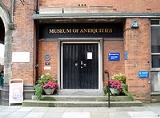
Museum of Antiquities
Encyclopedia
The Museum of Antiquities was an archaeological museum at the University of Newcastle upon Tyne
, England
. It opened in 1960 and in 2009 its collections were merged into the Great North Museum: Hancock.
and the University of Newcastle upon Tyne
. It was the main archaeology museum in north east England
. It covered the history of the region, especially Hadrian's Wall
and the Roman
period in general. It included a full-scale reconstruction of the 3rd century temple dedicated to the Roman god Mithras at Carrawburgh
. Overall, the period from early prehistory to the 17th century was covered. The University's memorabilia shop was also located inside.
As part of the Great North Museum
Project the museum, along with Shefton Museum
was moved to the Hancock Museum
. On 19 April 2008 the museum closed in preparation for the relocation to the newly renovated Hancock Museum, which reopened in May 2009.
for Museum of the Year in 2004. The museum was also supported by the Heriatage Lottery Fund.
University of Newcastle upon Tyne
Newcastle University is a major research-intensive university located in Newcastle upon Tyne in the north-east of England. It was established as a School of Medicine and Surgery in 1834 and became the University of Newcastle upon Tyne by an Act of Parliament in August 1963. Newcastle University is...
, England
England
England is a country that is part of the United Kingdom. It shares land borders with Scotland to the north and Wales to the west; the Irish Sea is to the north west, the Celtic Sea to the south west, with the North Sea to the east and the English Channel to the south separating it from continental...
. It opened in 1960 and in 2009 its collections were merged into the Great North Museum: Hancock.
History
The museum was originally opened in 1960, and was jointly run by the Society of Antiquaries of Newcastle upon TyneSociety of Antiquaries of Newcastle upon Tyne
The Society of Antiquaries of Newcastle upon Tyne, the oldest provincial antiquarian society in England, was founded in 1813..It has had a long interest in the archaeology of the north-east of England, particularly of Hadrian's Wall, but also covering prehistoric and mediaeval periods, as well as...
and the University of Newcastle upon Tyne
Newcastle upon Tyne
Newcastle upon Tyne is a city and metropolitan borough of Tyne and Wear, in North East England. Historically a part of Northumberland, it is situated on the north bank of the River Tyne...
. It was the main archaeology museum in north east England
North East England
North East England is one of the nine official regions of England. It covers Northumberland, County Durham, Tyne and Wear, and Teesside . The only cities in the region are Durham, Newcastle upon Tyne and Sunderland...
. It covered the history of the region, especially Hadrian's Wall
Hadrian's Wall
Hadrian's Wall was a defensive fortification in Roman Britain. Begun in AD 122, during the rule of emperor Hadrian, it was the first of two fortifications built across Great Britain, the second being the Antonine Wall, lesser known of the two because its physical remains are less evident today.The...
and the Roman
Roman Britain
Roman Britain was the part of the island of Great Britain controlled by the Roman Empire from AD 43 until ca. AD 410.The Romans referred to the imperial province as Britannia, which eventually comprised all of the island of Great Britain south of the fluid frontier with Caledonia...
period in general. It included a full-scale reconstruction of the 3rd century temple dedicated to the Roman god Mithras at Carrawburgh
Carrawburgh
Carrawburgh is a settlement in Northumberland. In Roman times, it was the site of a 3½ acre auxiliary fort on Hadrian's Wall called Brocolitia, Procolita, or Brocolita This name is probably based on the Celtic name for the place, and one possible translation put forward is 'badger holes'...
. Overall, the period from early prehistory to the 17th century was covered. The University's memorabilia shop was also located inside.
As part of the Great North Museum
Great North Museum
The Great North Museum is a visitor attraction in Newcastle upon Tyne in North East England. It features two venues: the Great North Museum: Hancock and the Hatton Gallery...
Project the museum, along with Shefton Museum
Shefton Museum
The Shefton Museum of Greek Art and Archaeology was an archaeological museum at the University of Newcastle upon Tyne, England which opened in 1956 and closed in 2008. Its collections are now part of the Great North Museum.- History :...
was moved to the Hancock Museum
Hancock Museum
The Hancock Museum is a museum of natural history in Newcastle upon Tyne, England, established in 1884. In 2006 it merged with Newcastle University's Hatton Gallery to form the Great North Museum. The museum and all of its collections are owned by the Natural History Society of Northumbria,...
. On 19 April 2008 the museum closed in preparation for the relocation to the newly renovated Hancock Museum, which reopened in May 2009.
Awards
The museum was a finalist for the Gulbenkian PrizeGulbenkian Prize
The Art Fund Prize, formerly known as the Gulbenkian Prize, is an annual prize awarded to a museum or gallery in the United Kingdom for a "track record of imagination, innovation and excellence"...
for Museum of the Year in 2004. The museum was also supported by the Heriatage Lottery Fund.
External links
- Museum website
- Virtual Temple of Mithras
- Great North Museum - the successor museum

